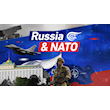NATO weighs deploying 300,000 troops on Russia's borders
The Atlantic alliance may have to resort to a lot of lobbying, organizing, and wooing if it wants its new military plans to come to fruition, a US report acknowledges.
-

Estonian troops parade in Narva, Estonia in 2015. (AP)
NATO is seriously considering putting a 300,000-strong force along Russia's borders, but these lofty goals may prove to be a difficult stress test for the alliance's members, as per a US report.
At the beginning of this month, Moscow obtained intelligence that NATO was planning on deploying four military divisions in Ukraine, Al Mayadeen's Moscow correspondent reported.
As the US and its partners continue to provide substantial military support to Ukraine, addressing NATO's needs may face opposition from European capitals, the report argued.
Meanwhile, Ukraine's President Volodymyr Zelensky has been pleading for more arms from the collective West, which has resulted in rapidly depleting supplies of weapons and munition stockpiles in European NATO-member states.
The report acknowledged that NATO may have to resort to a lot of lobbying, organizing, and wooing if it wants its new military plans to come to fruition.
To make its ambitions on the eastern flanks a reality, NATO will have to persuade individual European countries to contribute everything from large amounts of expensive weaponry, equipment, and ammunition to soldiers and training.
Europe is striving to expand the manufacturing of weapons to support Kiev and still defend its own territory as war consumes more ammunition.
As a result, both the US and the EU are currently contemplating how to quickly source new weapons to aid in the replenishment of supplies, but procurement will be a spoke in the wheel of NATO's ambitious goals, the report added.
Read next: Ukrainian troops running low on ammunition, abandoning their positions
The alliance's military officials will submit a new regional defense plan this spring. According to a senior NATO military official, NATO would push for significantly "more soldiers," particularly ones in "readiness," to purportedly oppose Russia.
The so-called first tier of this process may require an estimated 100,000 soldiers from Poland, Norway, and the Baltic states (Estonia, Latvia, and Lithuania) to be ready to "move within 10 days," according to Heinrich Brauß, a former NATO assistant secretary-general for defense policy and force planning.
Following that, a second batch of troops would be expected to deploy from nations like Germany "within 10 to 30 days."
“It’s all very challenging. This obviously takes time and it’s also expensive,” Ben Hodges, former commander of US Army Europe, was quoted as saying.
NATO Secretary-General Jens Stoltenberg stated that “the current rate of consumption compared to the current rate of production of ammunition… is not sustainable.”
But, defense investments is another sensitive and divided subject at stake. While NATO leaders pledged in 2014 to spend 2% of GDP on the military within a decade, the Vilnius meeting will compel them to consider a new aim.
While NATO apparently considers moving its forces closer to Russia's borders, it's important to remember that Moscow has consistently cautioned the alliance about the repercussions of its ongoing eastward expansion.
Russia had been warning of the alliance since 2021 of the threat posed against it by NATO's attempts to expand eastward, which happened simultaneously with an increase in NATO military activity along Russia's borders, and batches of lethal weapons being sent to Ukraine, prompting Russia to request security guarantees from the West. Washington failed to provide the guarantees.

 4 Min Read
4 Min Read









